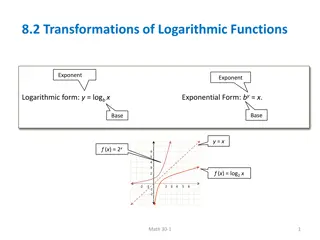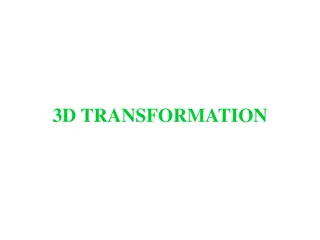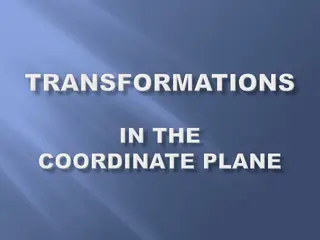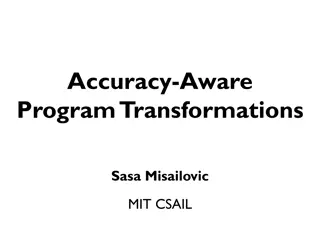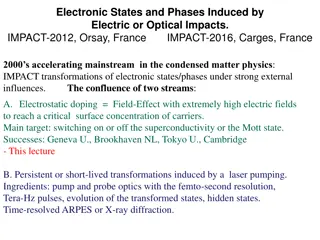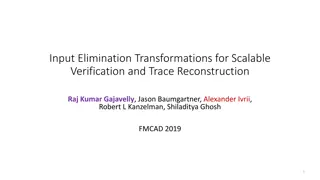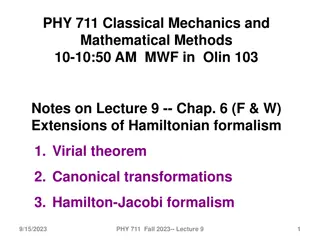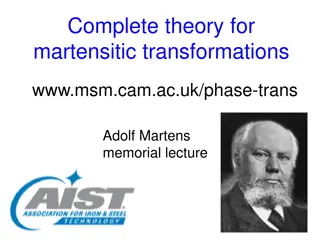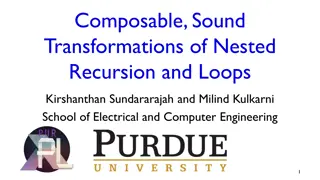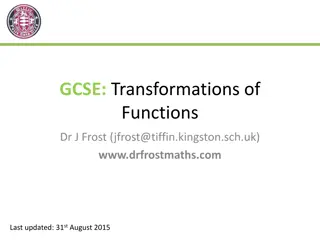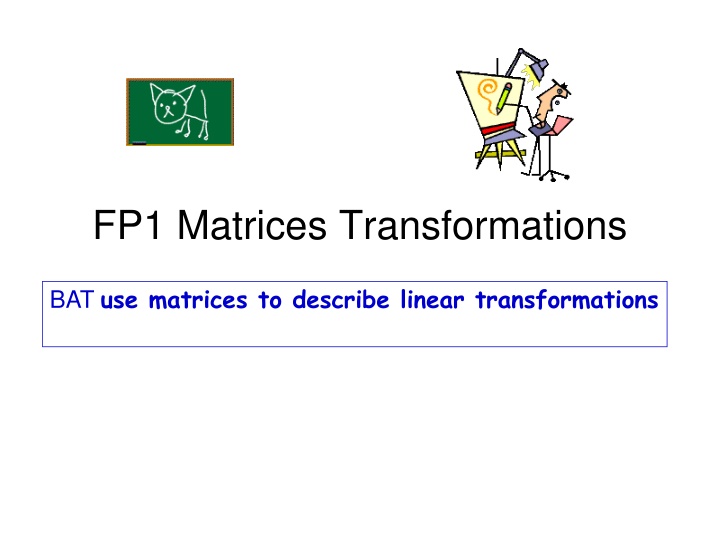
Using Matrices for Linear Transformations: Concepts and Applications
Explore how matrices can describe linear transformations and solve transformation problems by finding the image of points under specific transformations. Learn about properties of linear transformations, representing transformations with matrices, and transforming shapes using matrix operations.
Download Presentation

Please find below an Image/Link to download the presentation.
The content on the website is provided AS IS for your information and personal use only. It may not be sold, licensed, or shared on other websites without obtaining consent from the author. If you encounter any issues during the download, it is possible that the publisher has removed the file from their server.
You are allowed to download the files provided on this website for personal or commercial use, subject to the condition that they are used lawfully. All files are the property of their respective owners.
The content on the website is provided AS IS for your information and personal use only. It may not be sold, licensed, or shared on other websites without obtaining consent from the author.
E N D
Presentation Transcript
FP1 Matrices Transformations BAT use matrices to describe linear transformations
WB 1The three transformations S, T and U are defined as follows ? ? ? ? ? ? ? + 4 ? 1?: 2? ? ? + ??: 2? ?2 ?: Find the image of the point (2,3) under each of these transformations. ? ? ? + 4 ? 1 ? ? 2? ? ? + ? ?: You can write the coordinate as a vector (ie the directions from (0,0)) Sub in values ?: ?:2 2 + 4 3 1 ?:2 2 2 3 2 + 3 3 3 Calculate =6 =1 = 6,2 = 1,5 2 5 ? ? 2? ?2 A linear transformation has two properties It only involves linear transformations of x and y (so no powers) The origin, (0,0) is not moved by the transformation ?: 2(3) (2)2 ?:2 3 6 So T is the only linear transformation here! = 4= 6, 4
Matrix transformations ? ? ?? + ?? ?? + ?? The linear transformation: ?: ? ?= ?? + ?? ?? + ?? Can be represented by the matrix: ? =? ? ? Since: ? ? ? ? ? ? ? 2? ? ? + ? can be represented by ? =2 1 1 ?: 1
WB 2Find matrices to represent these linear transformations: ? ? 2? + ? 3? ? ? 2? 3? + ? ?: ?: Find the image of the point (1, 4) under each of these transformations. ? =1 2 0 1 3 2 0 9 3 1 4= 3 ? =0 2 1 0 3 2 1 6 5 1 4= 3
WB 3aThe square S has coordinates (1,1), (3,1), (3,3) and (1,3). a) Find the coordinates of the vertices of the image of S after the transformation given by the matrix: ? = 1 2 1 2 b) draw a diagram to show this transformation Write the coordinates of the vertices of the square as vectors, and combine them into a 2x4 matrix 3 3 1 3 1 1 3 1 Now transform this using M 3 3 1 3 =1 1 2 2 1 1 1 3 1 1 7 3 9 5 5 3 So the new vertices will be at: (1,3), (-1,7), (3,9) and (5,5)
WB 3bThe square S has coordinates (1,1), (3,1), (3,3) and (1,3). a) Find the coordinates of the vertices of the image of S after the transformation given by the matrix: ? = 1 2 1 2 b) draw a diagram to show this transformation Original Vertices (1,1), (3,1), (3,3) and (1,3) New Vertices (1,3), (-1,7), (3,9) and (5,5) 10 10 -10 10 -10 10 -10 -10
Matrix transformations:use matrices to represent rotations, reflections and enlargements Translations are not linear transformations (as the origin would move), so these will not be covered here (0,1) (1,0) To decide what transformation a matrix performs, you should consider its effect on two simple vectors (you can also think of them as coordinates) As a Matrix we could represent these coordinates as: 1 0 0 1
WB 4a a) Describe fully the geometrical transformation represented by this matrix: M =3 0 3 b) apply this transformation to the square S with coordinates (1,1), (3,1), (3,3) and (1,3). 0 (0,3) 3 0 0 3 1 0 0 1 =3 0 3 (0,1) 0 (1,0) (3,0) if the original coordinates are (1,0) and (0,1) then the coordinates of the image are (3, 0) and (0, 3) The coordinates have stretched outwards This matrix is an enlargement of scale factor 3, centre (0,0)
WB 4b EnlargementsDescribe fully the geometrical transformation represented by this matrix: M =3 0 b) apply this transformation to the square S with coordinates (1,1), (3,1), (3,3) and (1,3). 0 3 3 0 0 3 3 3 1 3 = 3 3 9 3 9 9 3 9 1 1 3 1 (3,3), (9,3), (9,9) and (3,9) 10 10 -10 10 -10 10 -10 -10 Original Vertices New Vertices
WB 5a a) Describe fully the geometrical transformation represented by this matrix: M = 1 0 1 b) apply this transformation to the square S with coordinates (1,1), (3,1), (3,3) and (1,3). 0 y = x 1 0 0 1 0 0 1 = 1 0 (0,1) 1 0 1 (-1,0) (1,0) (0,-1) if the original coordinates are (1,0) and (0,1) then the coordinates of the image are (-1, 0) and (0, -1) Be careful! This is not a reflection in y = x as the coordinates would not match up Both have moved 180 round the centre The transformation is therefore a rotation of 180 around (0,0)
WB 5b rotation 180Describe fully the geometrical transformation represented by this matrix: M = 1 b) apply this transformation to the square S with coordinates (1,1), (3,1), (3,3) and (1,3). 0 0 1 1 0 0 3 3 1 3 = 3 3 1 3 1 1 3 1 1 1 3 1 (-1, -1), (-3, -1), (-3, -3) and (-1, -3) 1 10 10 -10 10 -10 10 -10 -10 Original Vertices New Vertices
WB 6a a) Describe fully the geometrical transformation represented by this matrix: M = 1 b) apply this transformation to the square S with coordinates (1,1), (3,1), (3,3) and (1,3). 0 1 0 y = x (0,1) 0 1 0 1 0 0 1 0 1 0 = 1 1 (-1,0) (1,0) if the original coordinates are (1,0) and (0,1) then the coordinates of the image are (0, -1) and (-1, 0) (0,-1) y = -x A bit like WB5, this is not a reflection in y = x as the coordinates do not match up However, they have been reflected in a different way The transformation is therefore a reflection in the line y = -x
Describe fully the geometrical transformation 0 1 1 0 WB 6b reflection y=-x represented by this matrix: M = b) apply this transformation to the square S with coordinates (1,1), (3,1), (3,3) and (1,3). 0 1 0 3 3 1 3 = 1 1 1 3 3 3 3 1 1 1 3 1 (-1, -1), (-1, -3), (-3, -3) and ( -3, -1) 1 10 10 -10 10 -10 10 -10 -10 Original Vertices New Vertices
Activity 1 Explore other transformations using matrices



